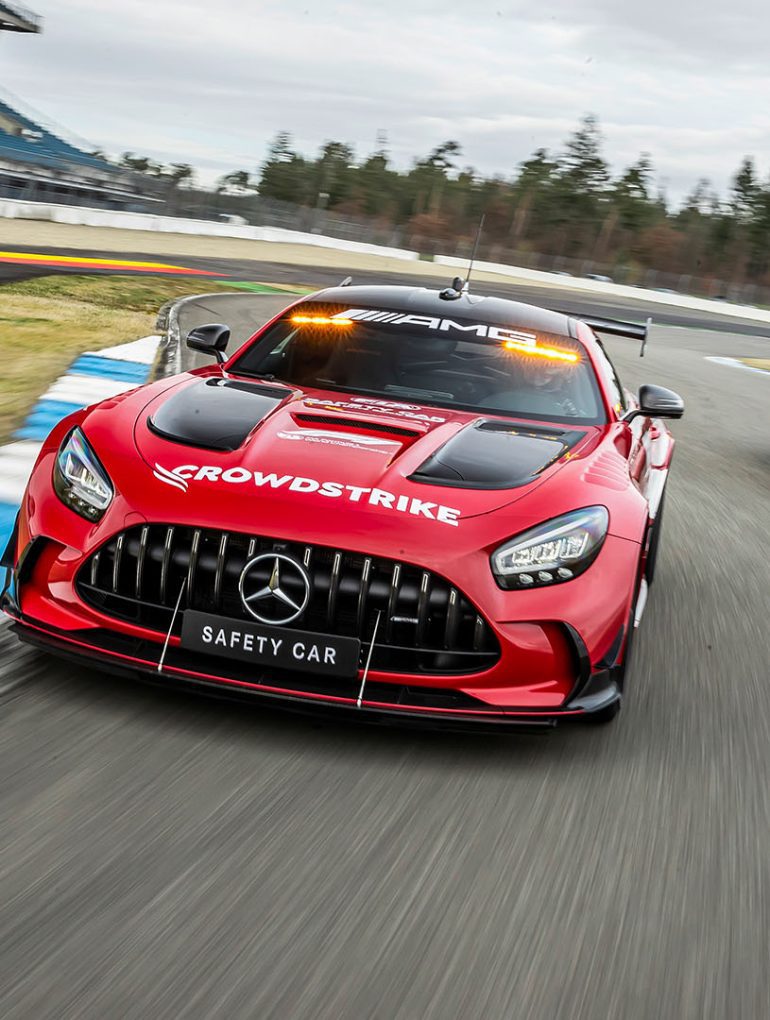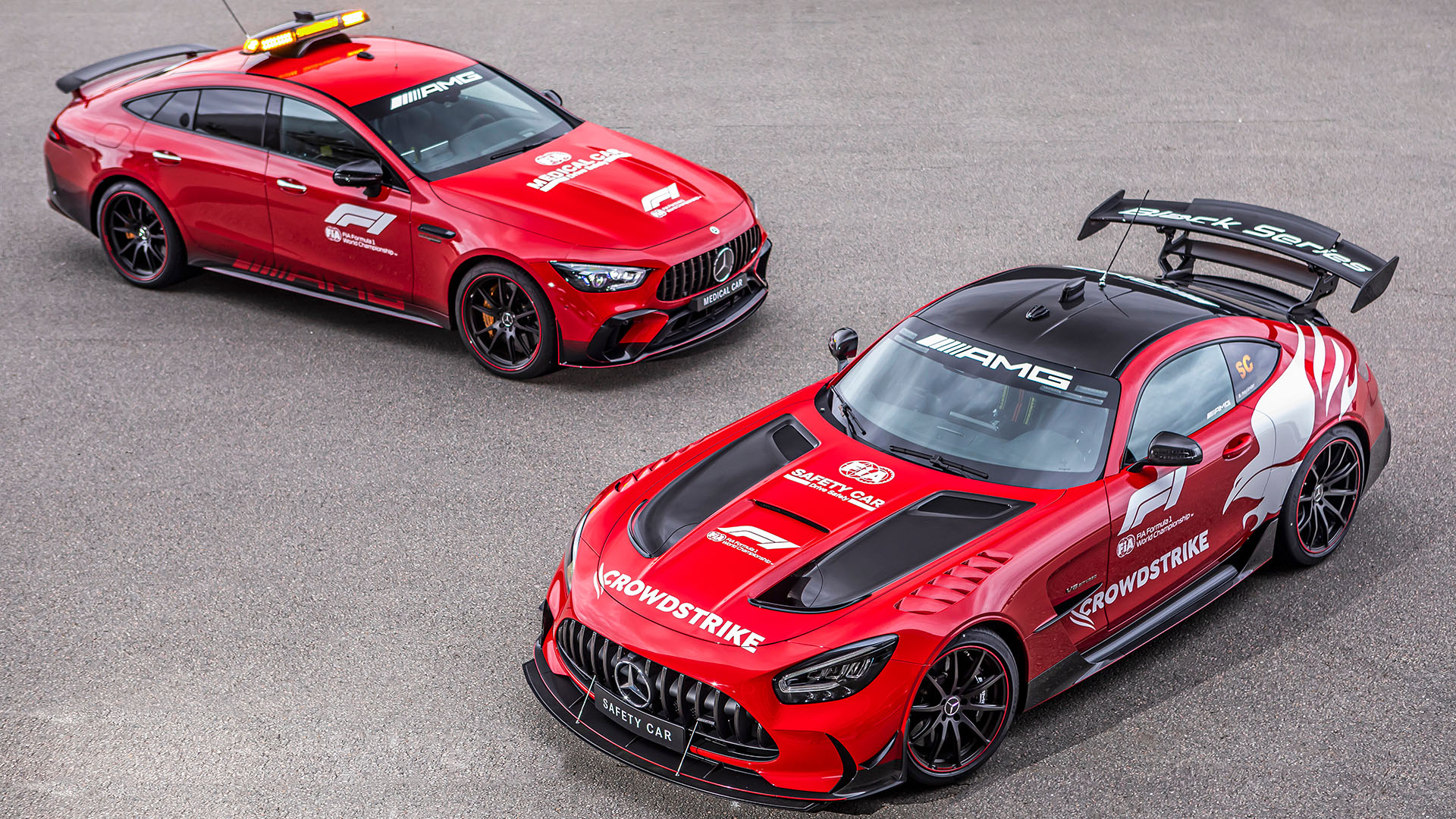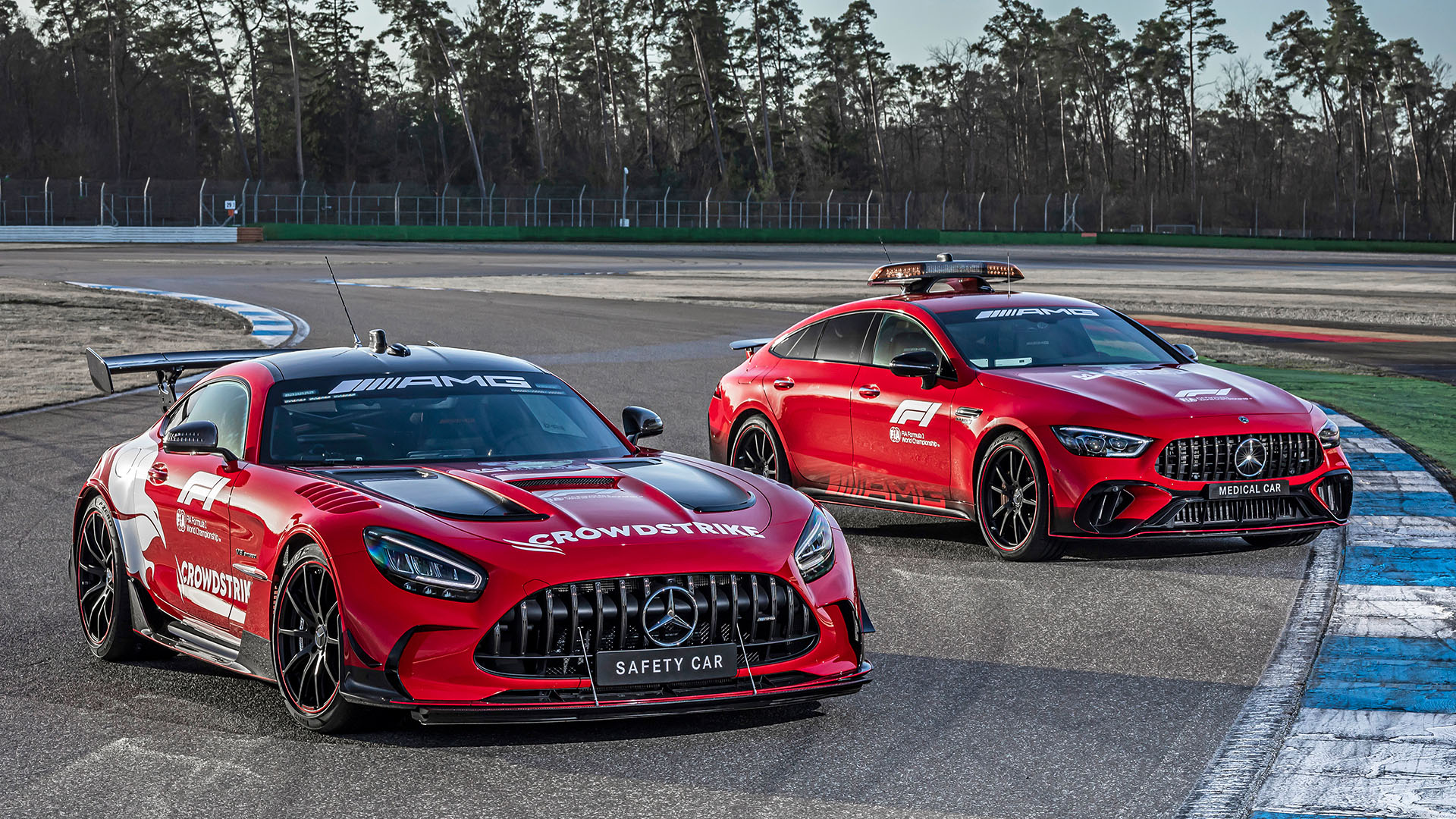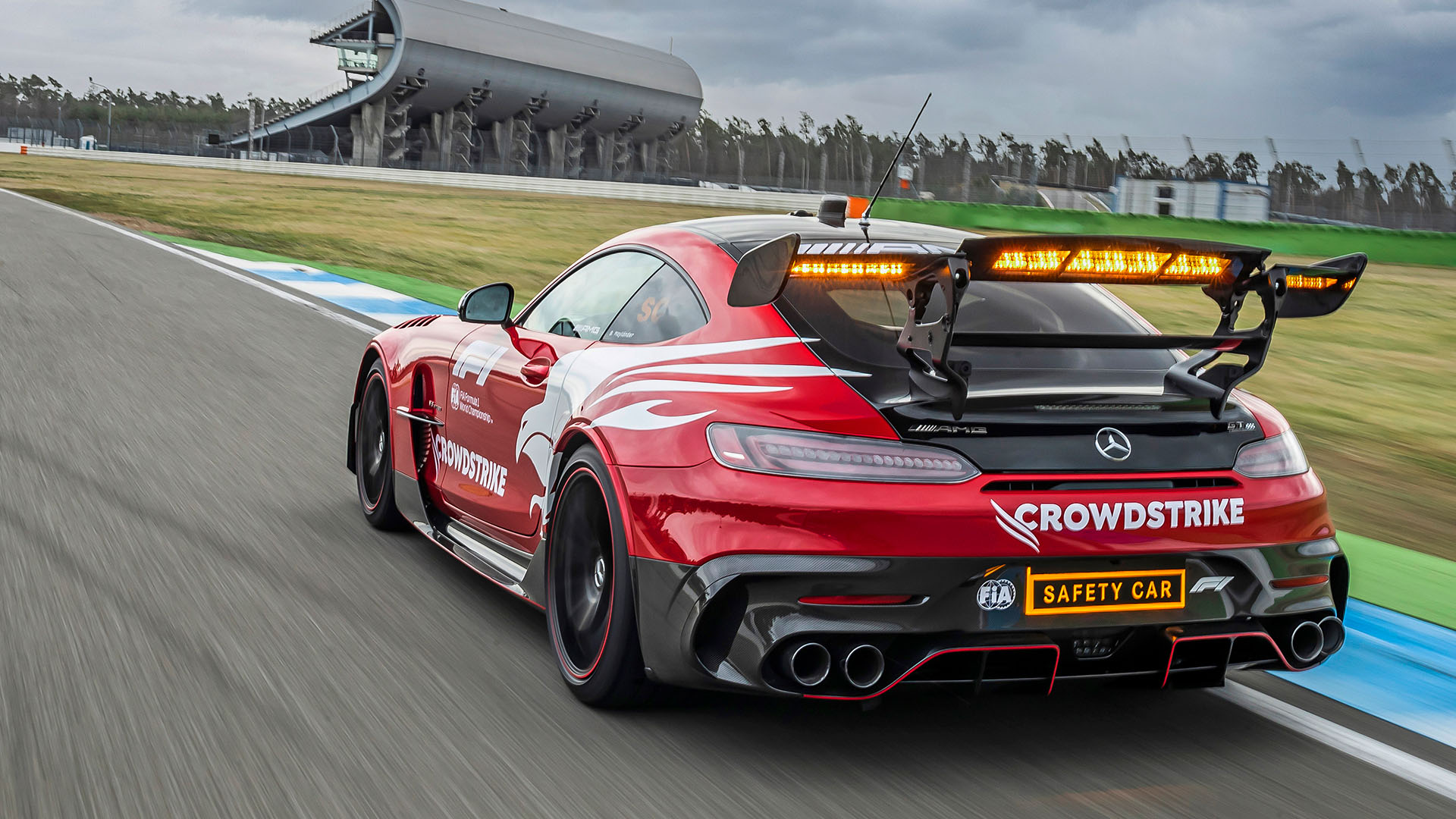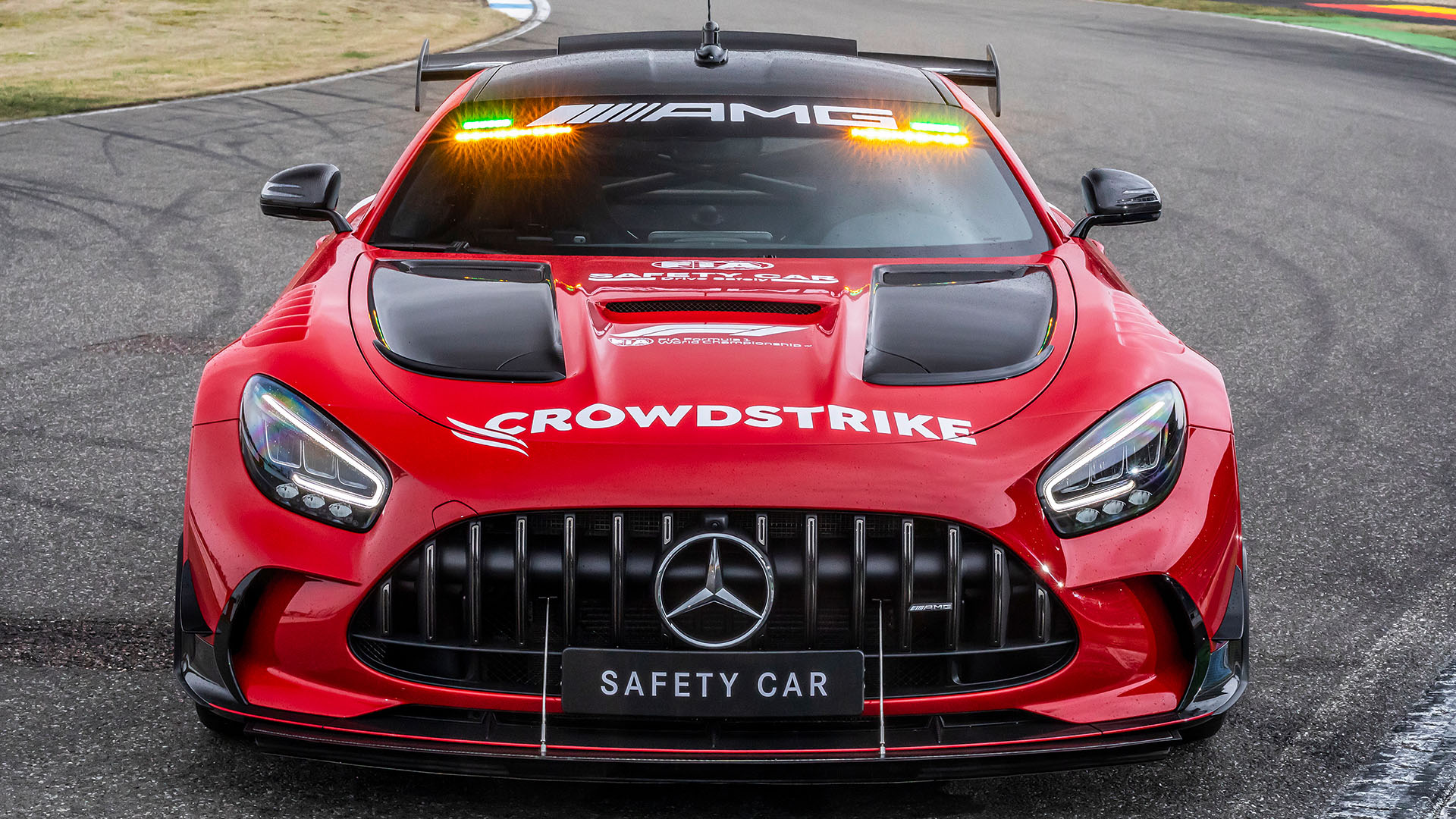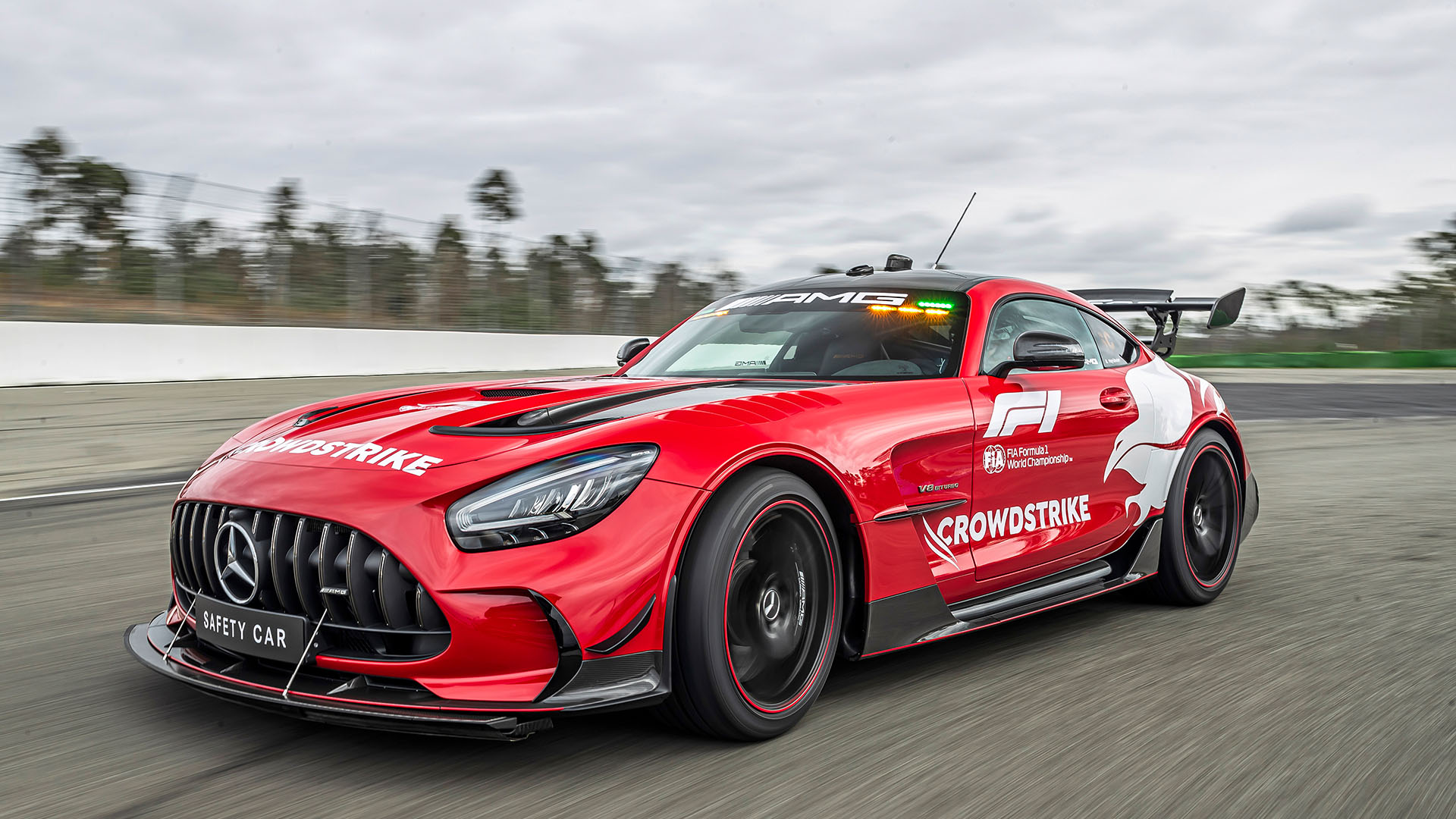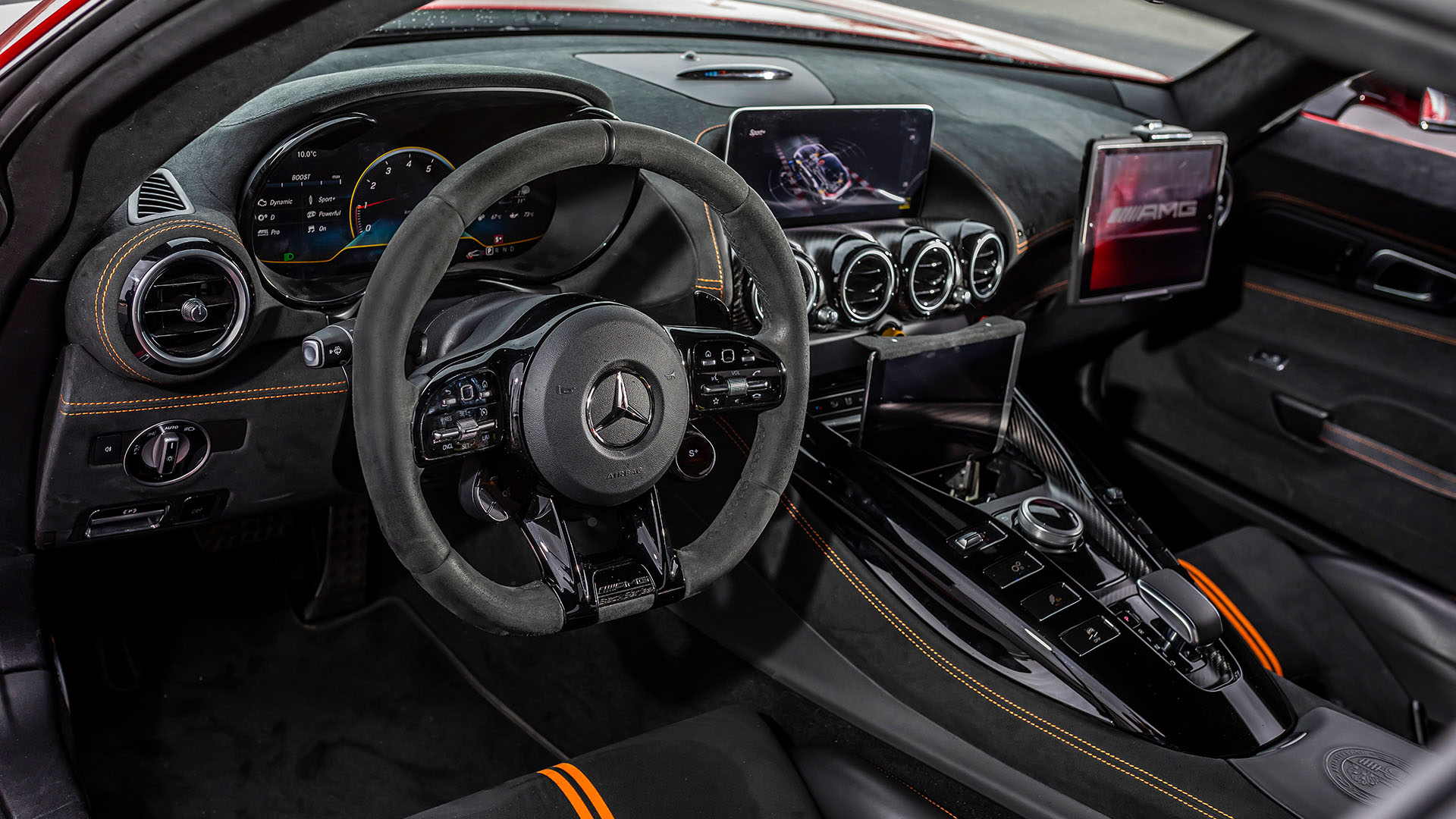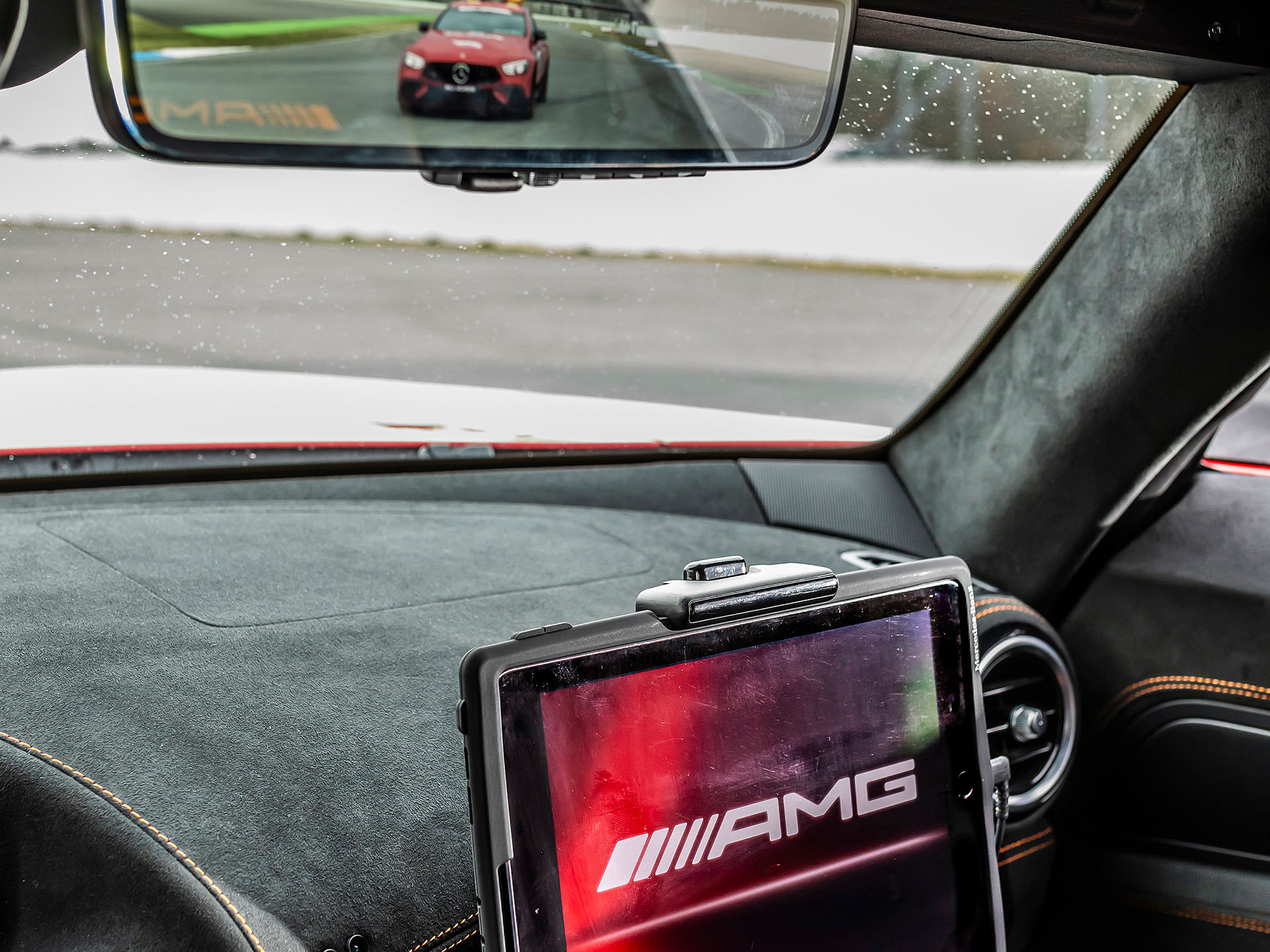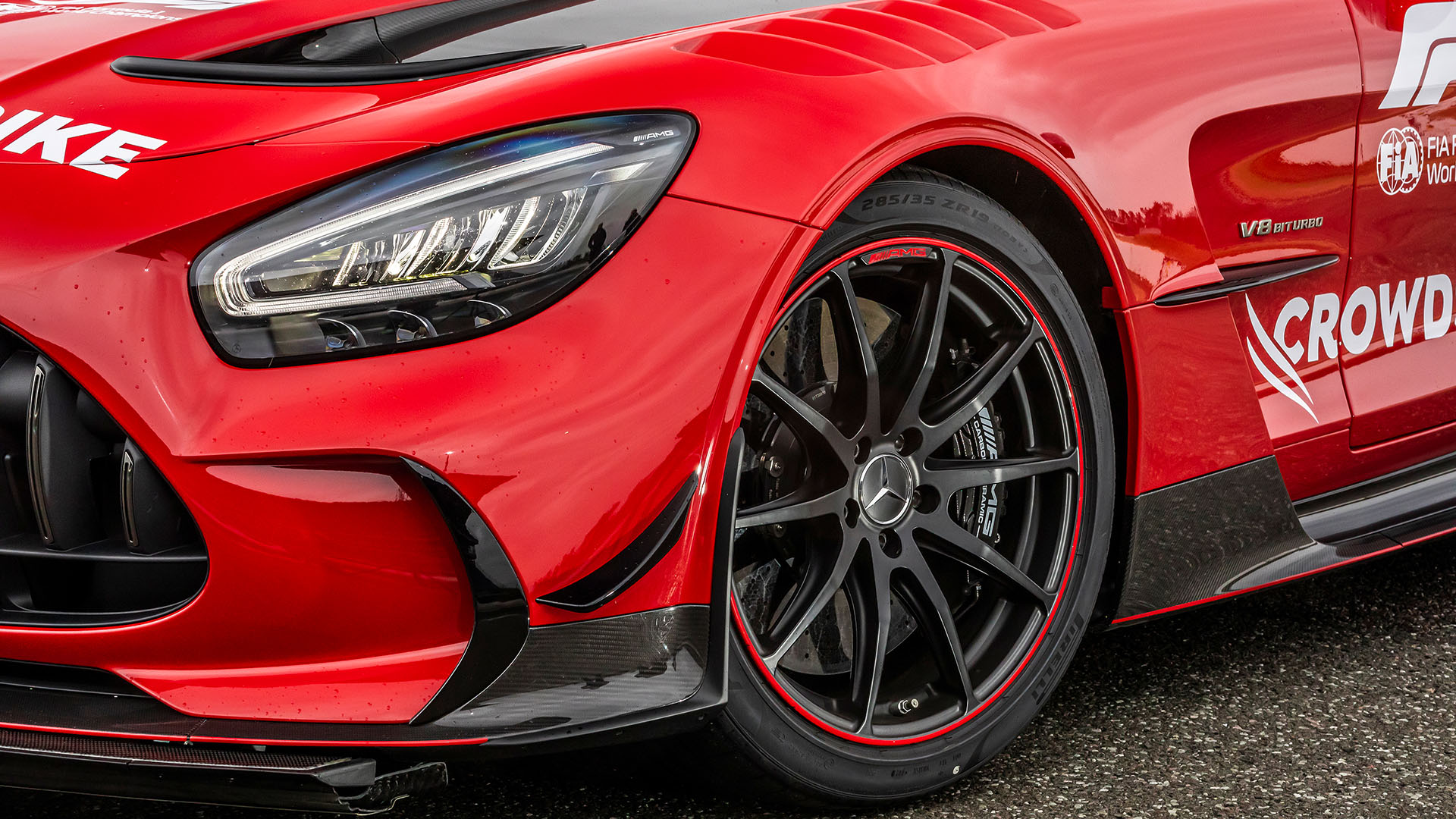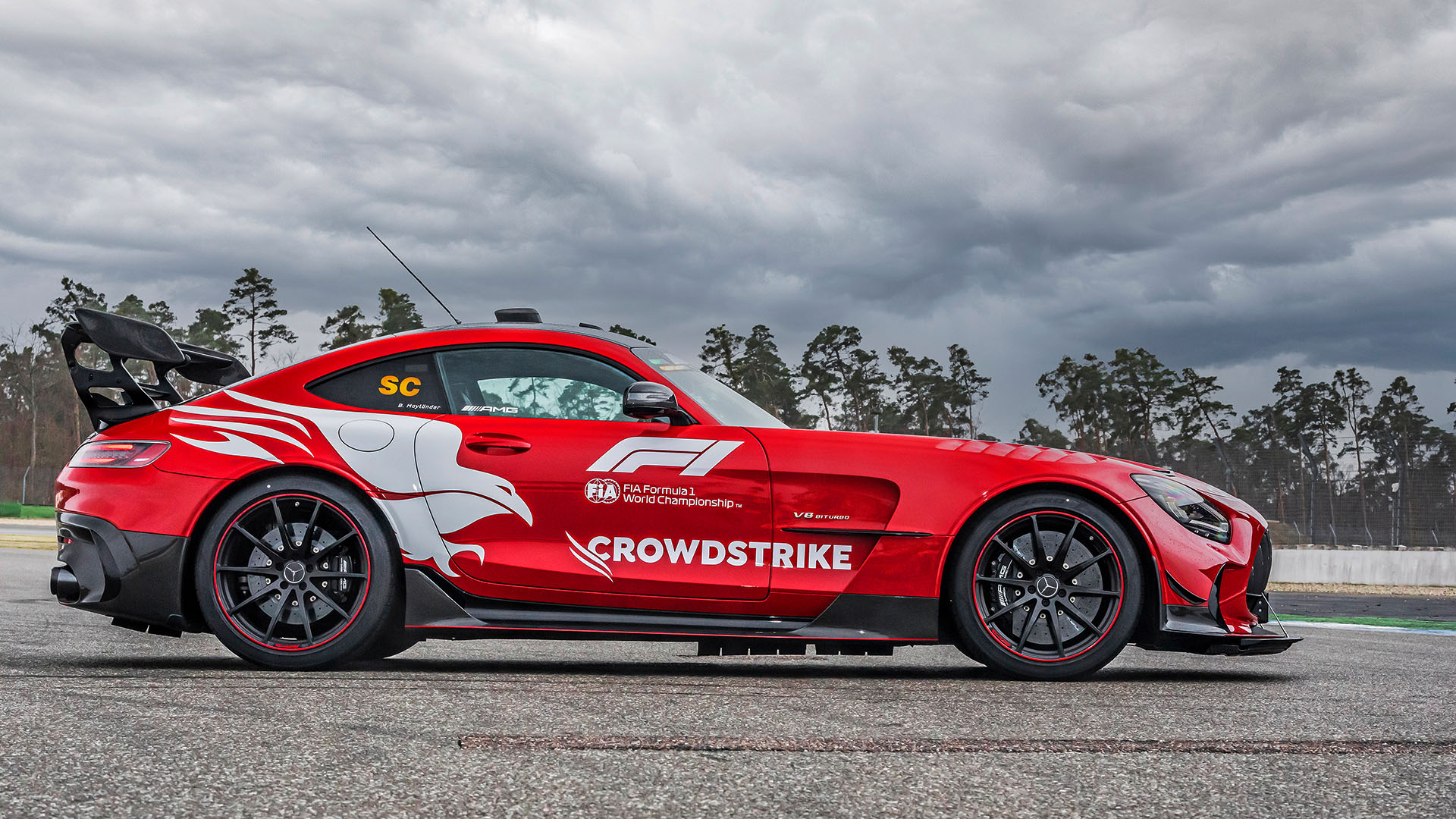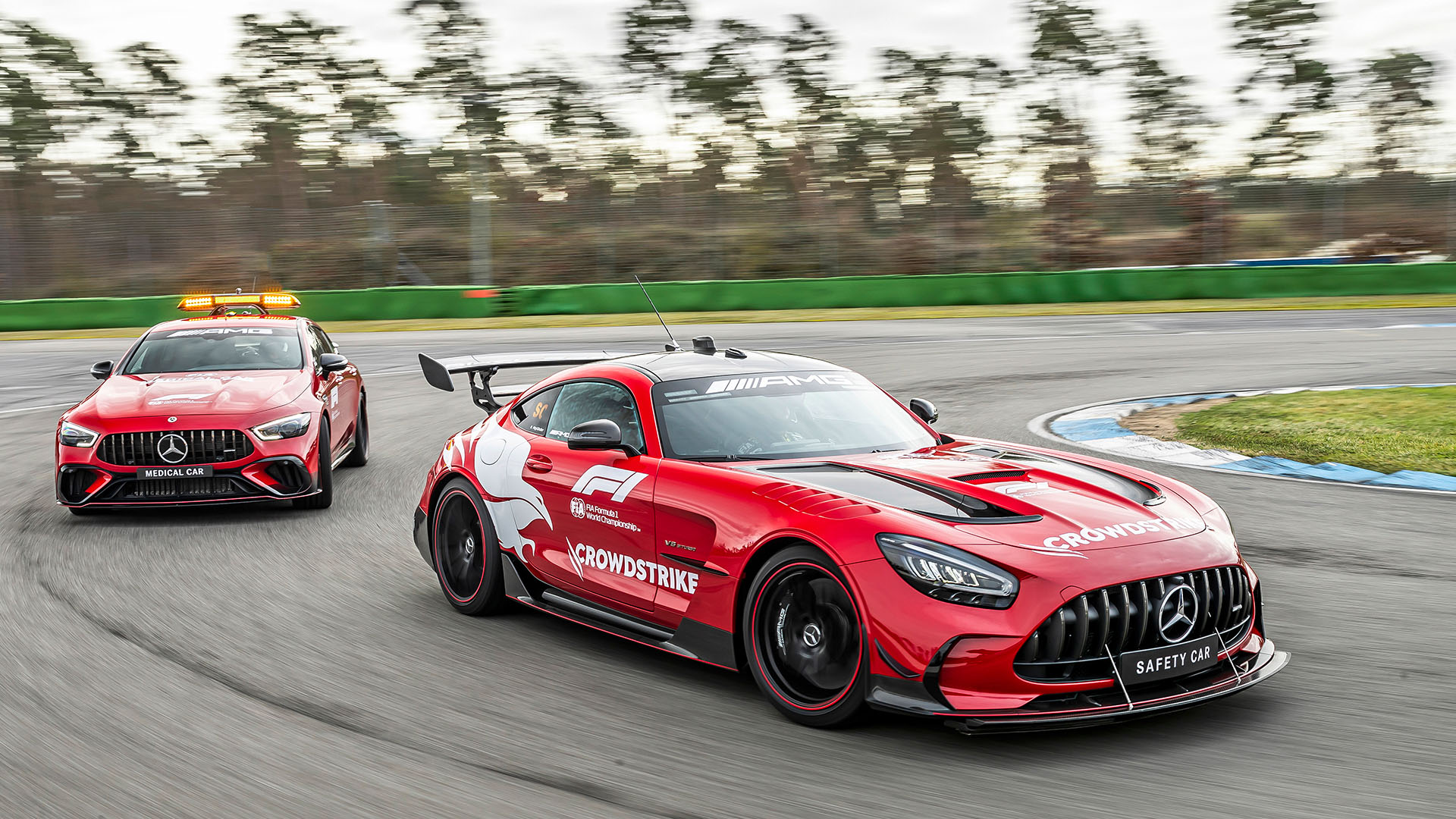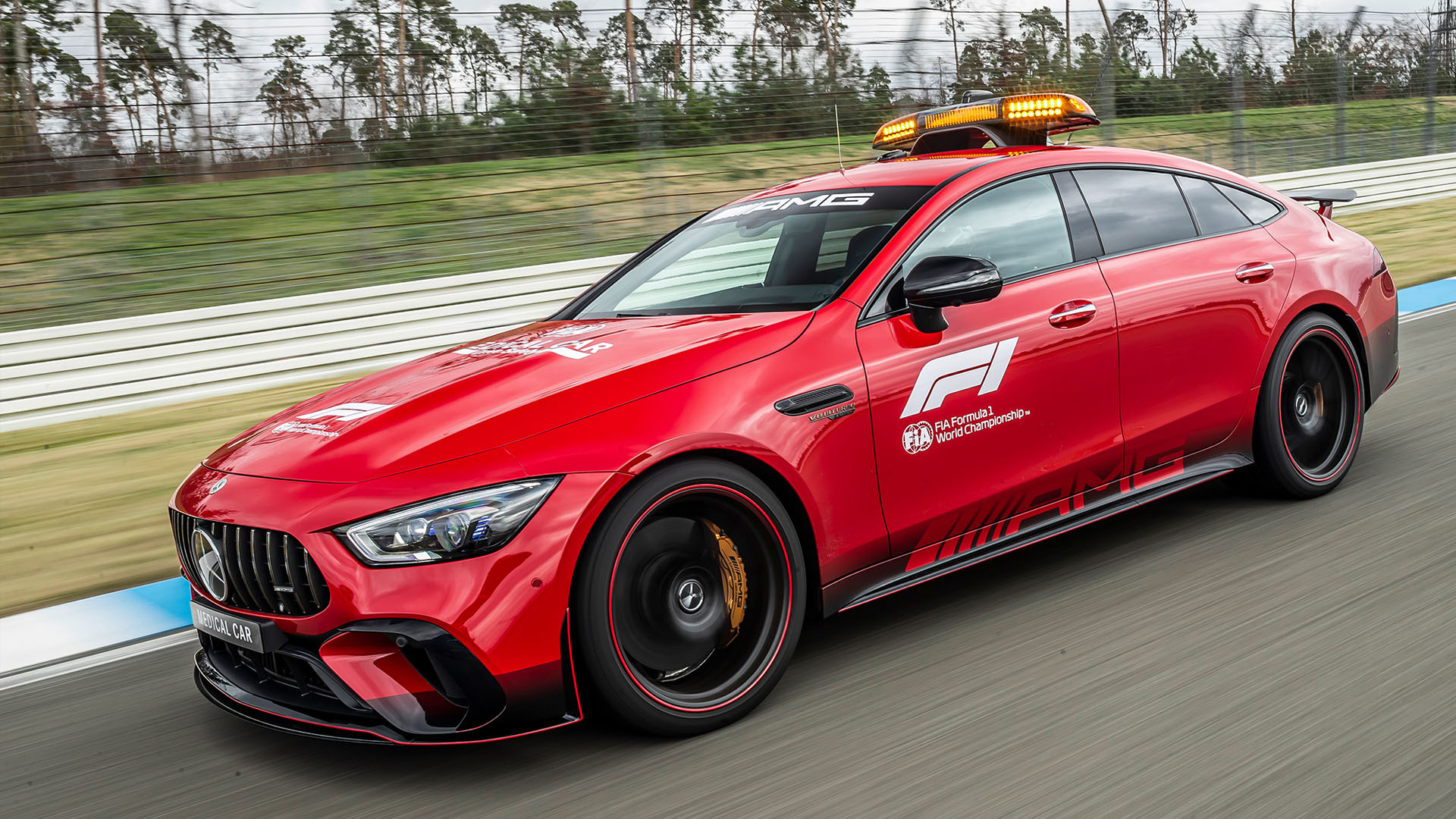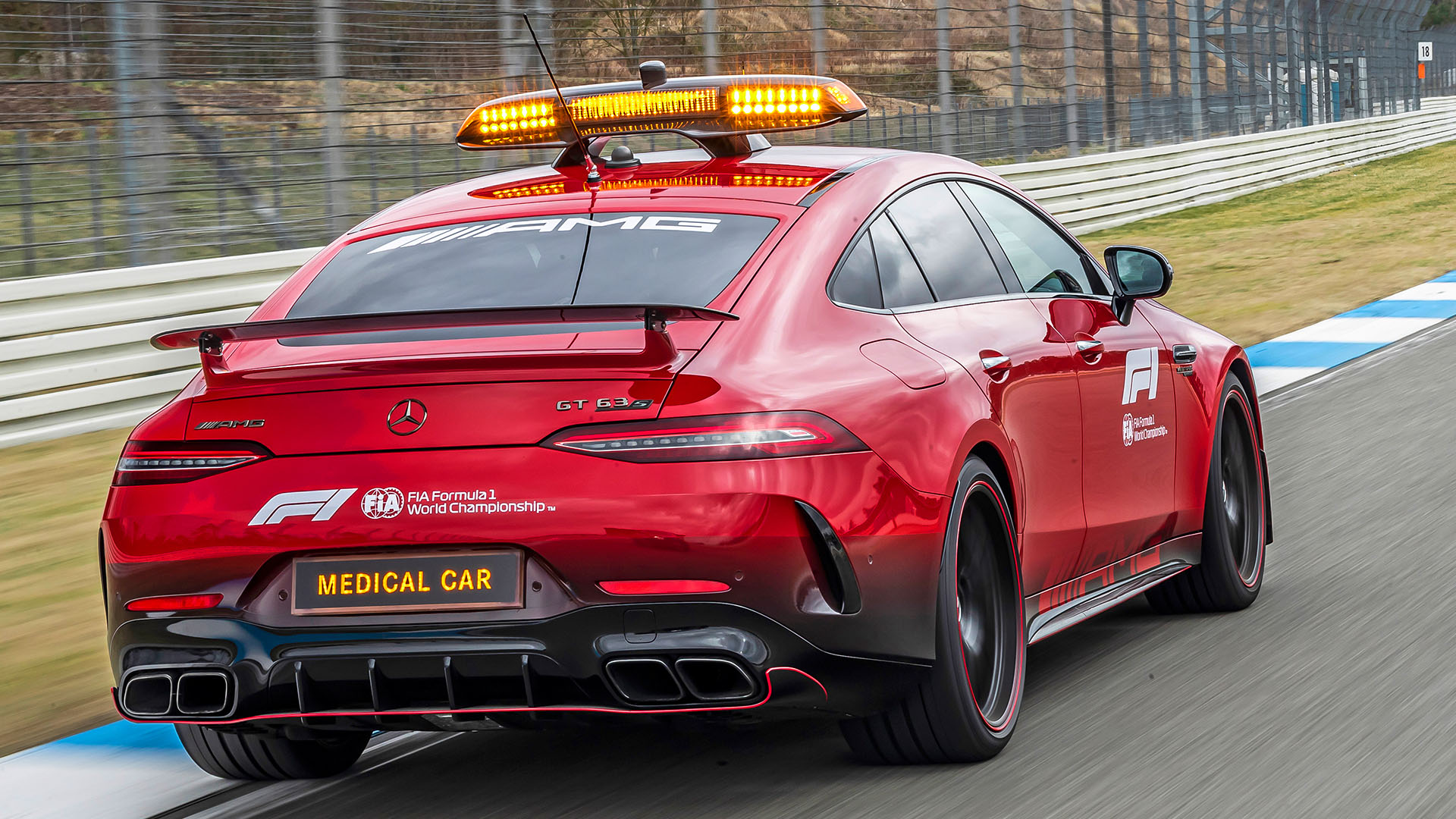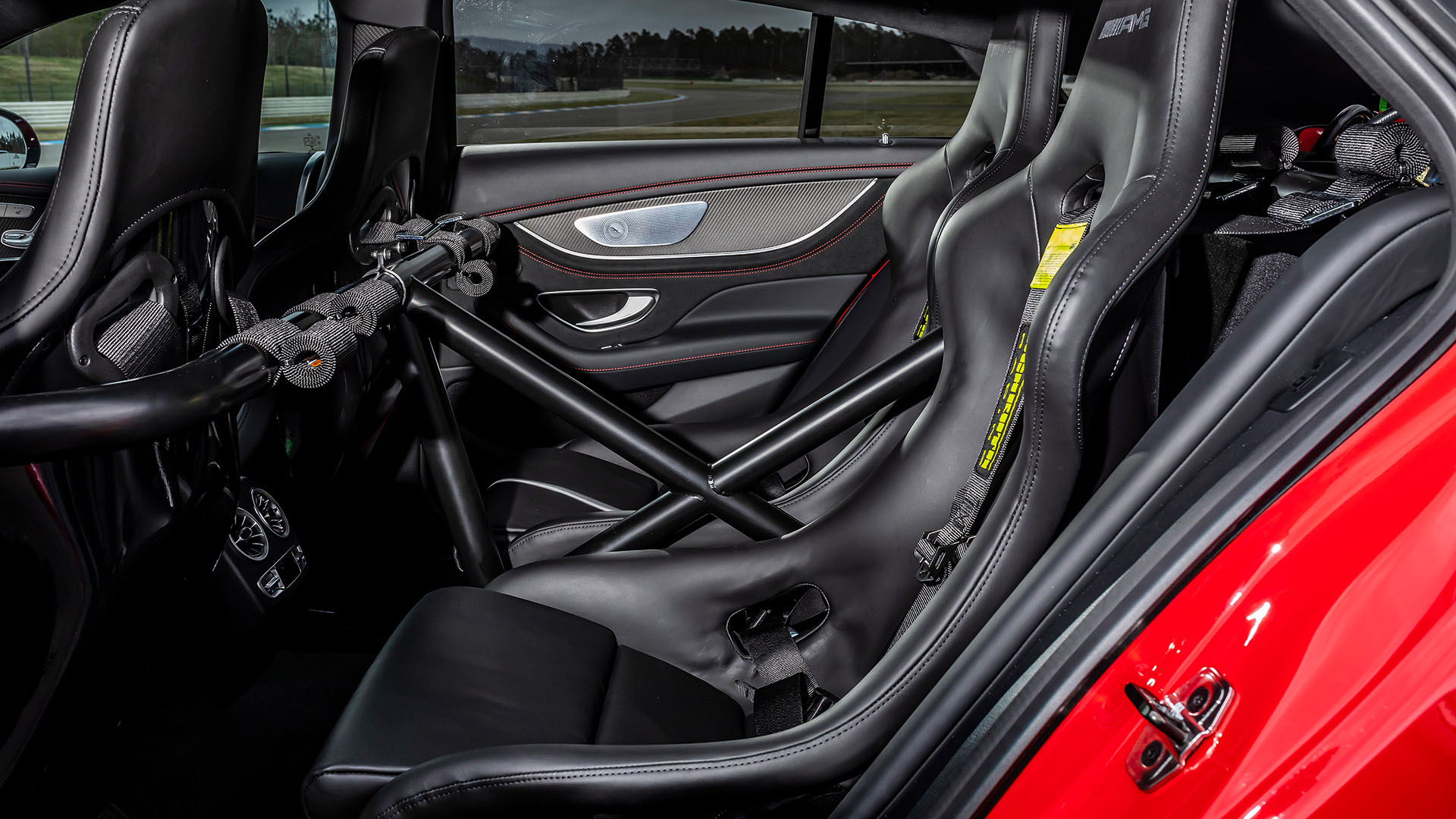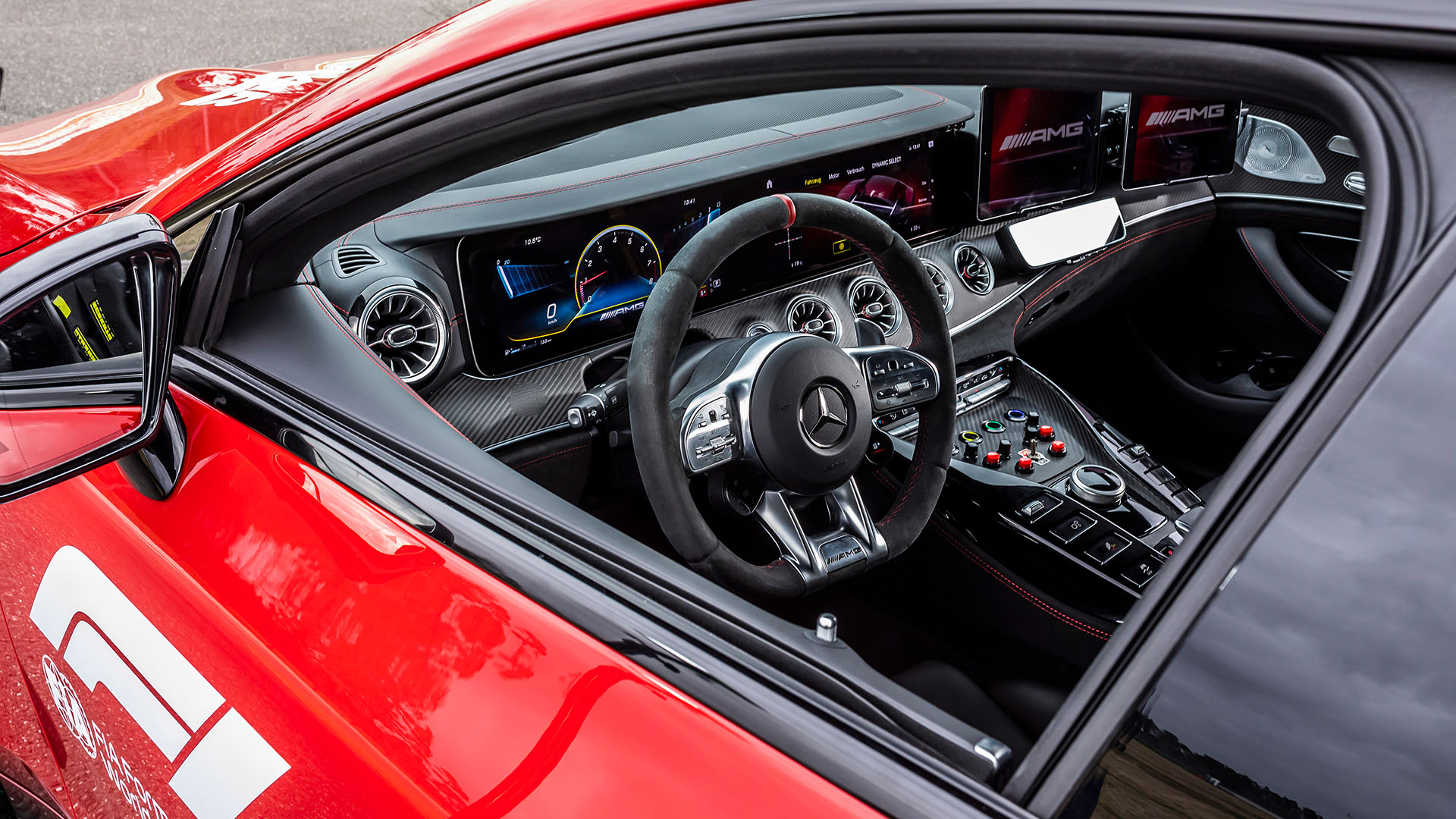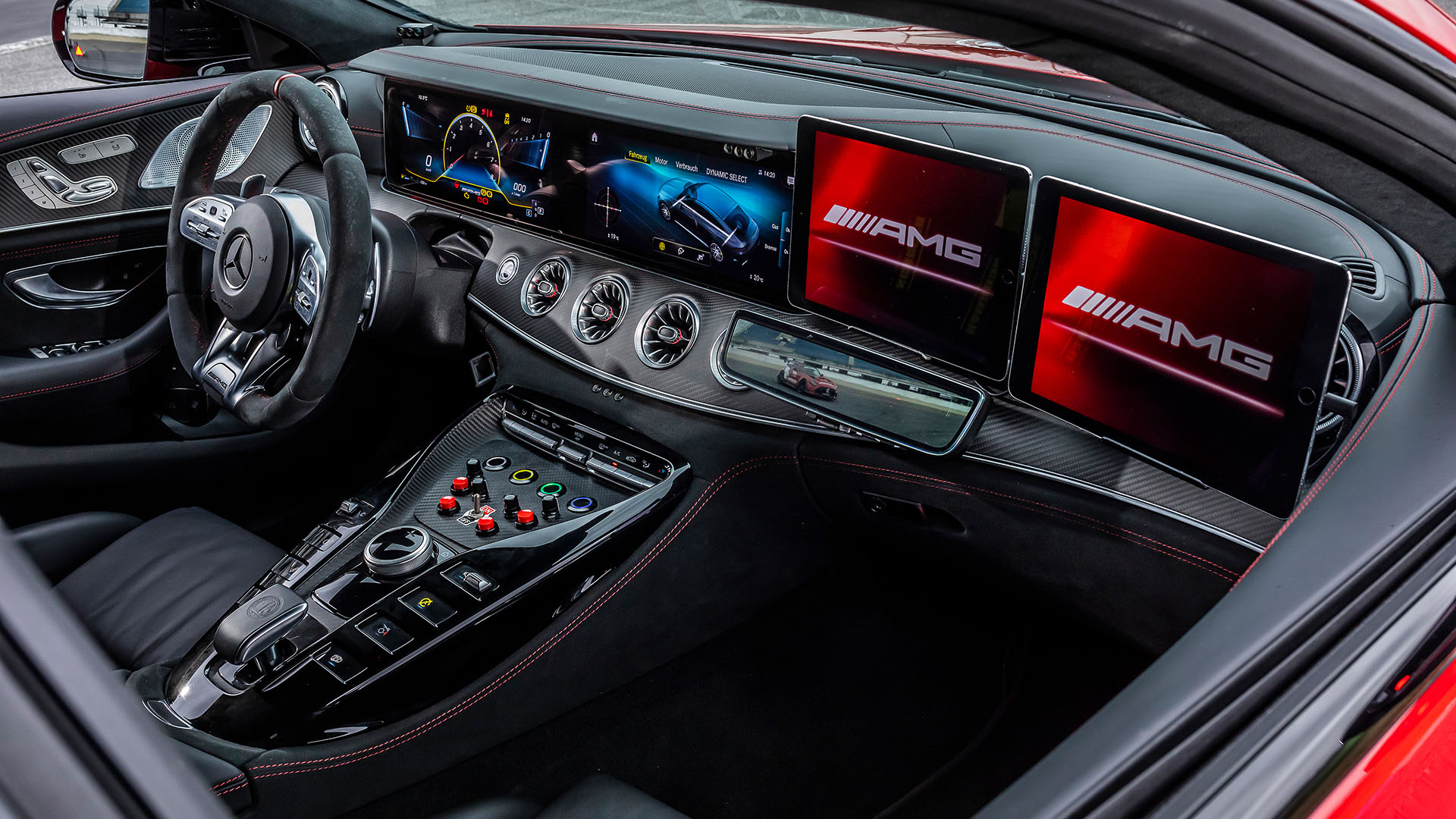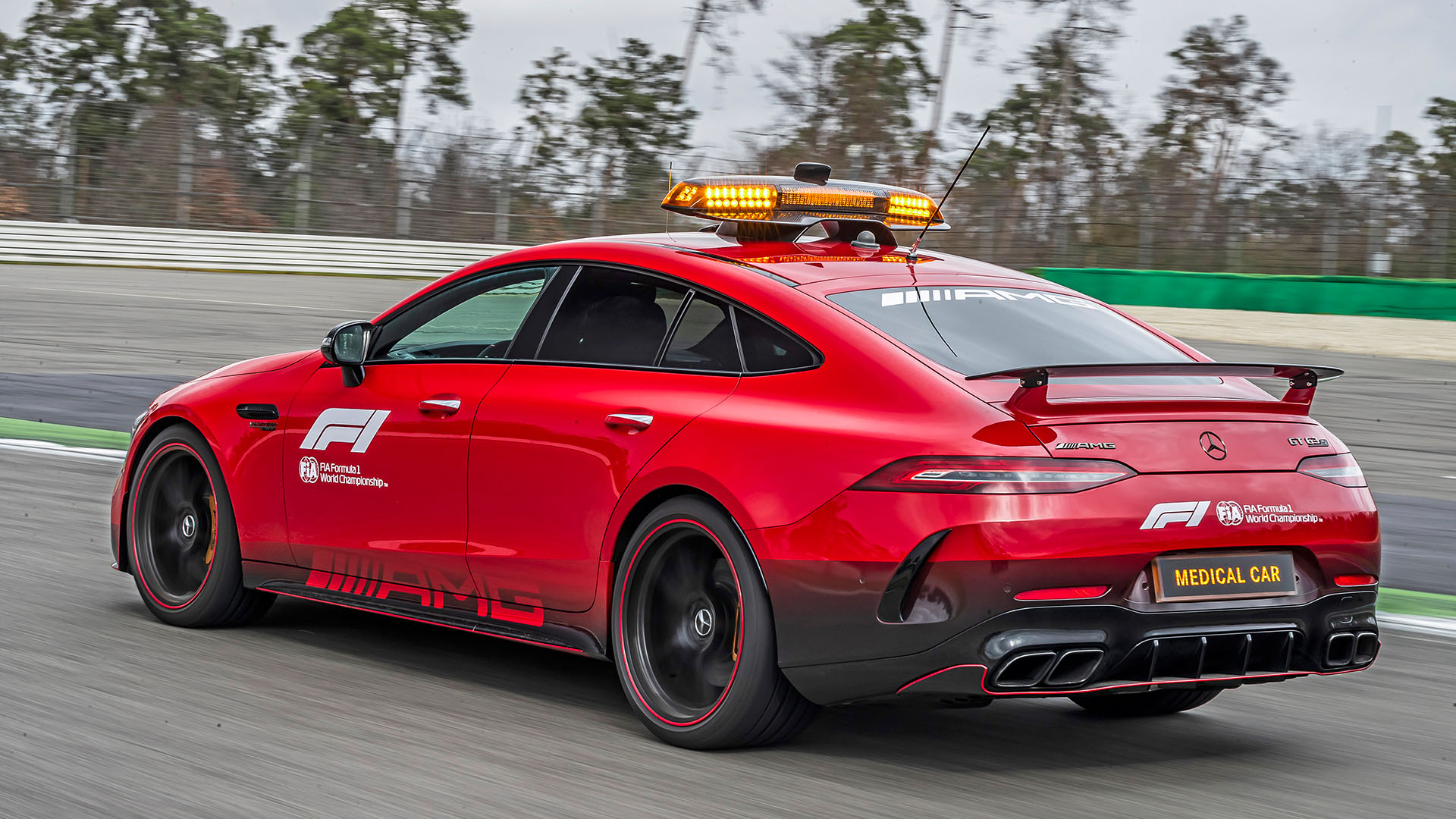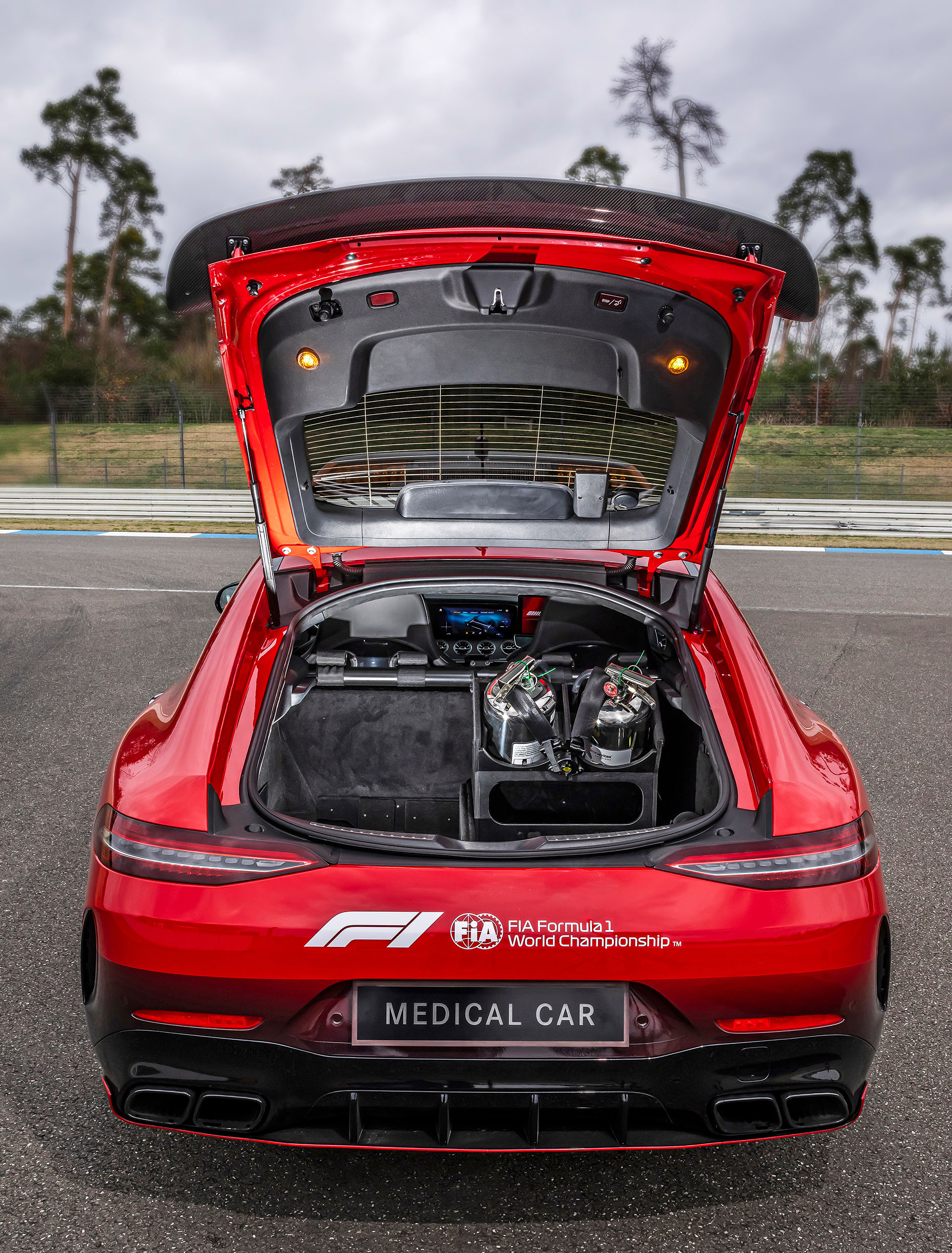When the season starts on 18-20 March with the FORMULA 1 GULF AIR BAHRAIN GRAND PRIX 2022, Mercedes-AMG will be contributing to the excellent safety of the FIA Formula One World ChampionshipTM with two exceptional performance models that have already well and truly proven their racetrack credentials. Appearing for the first time as the Official F1® Safety Car is the Mercedes-AMG GT Black Series (fuel consumption combined: 12.8 l/100 km, CO2 emissions combined: 292 g/km), while the MercedesAMG GT 63 S 4MATIC+ (fuel consumption combined: 13.5-13.0 l/100 km, CO2 emissions combined: 308295 g/km) makes its debut as Official F1® Medical Car. The 2022 season will benefit from the most powerful variants ever of these two vehicles.
“Recent years have seen Mercedes-AMG celebrate a huge number of amazing successes in the FIA Formula One World Championship. Eight constructors’ titles and seven drivers’ titles in the last eight years speak emphatically for themselves. Added to that is the extensive and widespread transfer of technology and image from this greatest of all motorsport stages and our series-production vehicles. Motorsport means so much to us, as does the best possible level of safety. There was absolutely no question that, after more than 25 years, we would extend our commitment as the provider of the safety car and medical car – with two absolutely outstanding vehicles from our line-up”, explains Philipp Schiemer, CEO of Mercedes-AMG GmbH.
“Since 1996 – that’s every single year for more than a quarter of a century – Mercedes-AMG has been supplying the vehicles Formula 1 needs in emergencies. In their role as Official F1 Safety Car, our performance vehicles have been safely leading the Formula 1 field around the track when called upon in bad weather or in the event of an incident. When needed, our Official F1 Medical Car is on the spot as quickly as possible. To ensure this, we have upped the ante even further for the 2022 season with our most powerful models to date, the AMG GT Black Series and the AMG GT 63 S. What’s more, their on-track performance displays their unfiltered motorsport DNA more than any of their predecessors. As always, of course, I nevertheless hope that these vehicles are called upon for support as little as possible”, says Christoph Sagemüller, Head of Motorsport of Mercedes-AMG GmbH.
Bernd Mayländer, who has been driving the FIA Formula One World ChampionshipTM Official Safety Car since 2000 says: “I’m so happy that I will once again be at the wheel of the Formula 1 safety car for the 2022 season. And I’m especially pleased that this year it’s a Mercedes-AMG GT Black Series. I’ve already had the chance to test this amazing vehicle many times and I’m simply blown away by how close it is to a thoroughbred race car. It really is a major step compared to last year’s GT R – which was already at an extremely high level. To have a workplace like this in the name of safety is a dream come true.”
Safety car signaling seamlessly integrated into the vehicle for the first time
From a technical standpoint, both cars are almost entirely standard. However, they have extensive equipment specific to their respective jobs on the track. The most noticeable feature of the Official F1® Safety Car is the absence of the usual light bar on the roof, which would have interfered with the carefully refined aerodynamic balance of the AMG GT Black Series. Instead, development engineers in Affalterbach came up with something completely new. At the front, the obligatory signaling has been incorporated into the upper area of the windscreen, while the rearward-facing lights have been elegantly integrated into the rear spoiler. All signaling functions are delivered via fast-reacting and energy-efficient LED lights.
Front module level with sun visors
At the front, three small orange light modules and one large green module are positioned on each side of the AMG logo, level with the sun visors. In the main upper blade of the rear spoiler are 13 orange lights – three on the outer edges on either side that shine steadily, and seven further lights in the center that flash when required. There are also a further four wider, green LED modules. Two tiny video cameras are installed into the spoiler strut on the right-hand side and their images are displayed inside the car. One camera serves as an electronic rear-view mirror for the co-driver (small monitor in the headliner to the right of the conventional rear-view mirror), while the other transmits a live TV stream. As a service for the spectators in the stands, there is also a light module in each of the rear side windows which displays “SC” (for Safety Car) in orange when the car is in action.
Overview of the safety light functions:
Orange: As soon as the safety car is called into service, the orange LEDs are switched on. The orange lights flashing in the center section at the rear and shining steadily on either side at the front mean “absolutely no overtaking”.
Green: If the AMG GT Black Series enters the track in the middle of the field at the start of a safety car phase, the green modules front and rear are activated. This signals to the racing drivers that they can overtake the safety car.
All modules are fully dimmable to allow the intensity of the light to be adapted to the conditions: for instance, night-time racing under floodlights or very strong sunlight by day.
The rear number plate is also illuminated in either orange or green in synch with the safety lights. Likewise, the headlights and rear lights have an important role to play in the signaling. Whenever the safety car is on the track, their rapid flashing draws even more attention.
Standard interior with AMG Track Package
The interior of the Official F1® Safety Car is the same as that of the standard AMG GT Black Series with the optional Track Package including rollover protection. The lightweight roll cage made from bolted tubular titanium consists of a main frame, a belt-fixture brace, two rear braces, and a diagonal cross at the rear. The system increases the already excellent vehicle stiffness even further and thus has a positive influence on vehicle performance. It also improves passive safety.
Additional monitors for watching the track
The only new features are the six-point safety harnesses stipulated by the FIA (Fédération Internationale de l’Automobile) and two tablets in the center console and instrument panel in front of the passenger seat. They enable co-driver Richard Darker to monitor the Formula 1® field. Displayed on the left tablet in the center console is the international TV signal. And the right monitor can be switched between the animated representation showing the current position of the race cars on the track or the current lap times. Data management for the visual communication tools is handled by an InCar Hotspot with WLAN. While Bernd Mayländer is concentrating on the track and simultaneously keeping an eye on things in the rearview mirror, Richard Darker maintains radio contact with the race control. In the center console are two red buttons for controlling all radio commands plus two rotary knobs for adjusting the volume. Mayländer and Darker also speak to one another via radio intercom. The cockpit is equipped with a second radio system as an emergency backup.
The lightweight bucket seats are part of the Track Package that can also be ordered by any customer. In the Official F1® Safety Car, however, a small cup holder is installed in the side cushions to accommodate a water bottle. Control of the light signaling is via a panel mounted at the front of the headliner, with round, color-coded buttons enabling accurate switching when wearing racing gloves.
FIA-specific systems identical to those in Formula 1® race cars
Further additional FIA-specific systems are also installed and are identical to those in every Formula 1® race car. They include the transponder system for timekeeping, the high-resolution GPS, and the telemetry. Likewise integrated is the “marshaling system”, which uses three colored LEDs in the instrument binnacle and in front of the co-driver to show the flag signals for the respective section of the track. In addition to that, there is the “medical warning light”. In the event of an accident on the track that exceeds a critical g-force threshold, the LEDs flash several times. This provides Bernd Mayländer and Richard Darker with an additional warning to prepare for action.
Developed especially for demanding racetrack service
High cornering speeds, dynamic sprints, and fast lap times – the FIA sets a demanding job profile for the Safety Car. The bottom line is that it must be able to lead the race cars from the very top class of motorsport safely around the track in extreme situations. And the safety car is not allowed to drive too slowly as that could lead to the tires and brakes of the Formula 1 cars cooling down too much and causing their engines to overheat.
The AMG GT Black Series has all the necessary credentials for the tough job at the very highest end of motorsport. The front-mid-engine with transaxle configuration, the V8 bi-turbo engine with dry-sump lubrication, the dual-clutch transmission, and the highly tuned chassis with aluminum double-wishbone suspension deliver the fundamentals for fast laps on a racetrack. The intelligent material-mix lightweight structure guarantees not only a low overall vehicle weight but also a low center-of-gravity and beneficial weight distribution.
Closer to motorsport than any other current road-legal AMG
The top model in the two-door AMG GT series was developed specifically for life on the racetrack, with 537 kW (730 hp), a stiffer body-in-white, the new highly adjustable suspension, intelligent lightweight engineering, and active aerodynamics. No other road-legal AMG model is currently closer to motorsport than this. That goes for everything from the AMG SPEEDSHIFT DCT 7G dual-clutch transmission to the twin-pipe exhaust system made from thin-gauge stainless steel with a titanium silencer. It also includes the chassis, which is manually height-adjustable and equipped with adaptive dampers, variable through three presets. The camber can be individually modified front and rear as can the settings of the anti-roll bars. Additional pivot bearings on the rear wishbones, carbon-fiber shear plates, and specially adapted, electronically controlled engine and transmission mount likewise further enhance the excellent handling and performance.
Suspension set-up, brakes, and aerodynamics tuned for the toughest demands
For the Official F1® Safety car, the suspension specialists in Affalterbach have engineered a set-up in combination with the Pirelli P Zero tires that offers the best possible solution for all racetracks and weather conditions. The standard-fit AMG ceramic high-performance composite brakes are exactly the same as those in the regular AMG GT Black Series. The same applies to the finely tuned aerodynamics with a large front skirt, additional flaps, a bigger front splitter, and the vertical tear-off edge on the rear skirt. Together with the two-blade rear wing with an additional, electronically controlled flap, the aerodynamics provide the AMG GT Black Series with optimum downforce and balance.
The acceleration and top speed are more than enough for the job. The standard production version of the Mercedes-AMG GT Black Series completes the sprint from zero to 100 km/h in 3.2 seconds and goes on to reach a top speed of 325 km/h.
Mercedes-AMG GT 63 S 4MATIC+ new Official F1® Medical Car
The Mercedes-AMG GT 63 S 4MATIC+ makes its Formula 1® debut as the second official car – taking over from its predecessor, the C 63 S AMG Estate (fuel consumption combined: 10.8 l/100 km, CO2 emissions combined: 246 g/km). The new Official F1® Medical Car is on standby for rapid emergency response and is crewed by up to three medics, including the FIA’s Medical Rescue Coordinator Dr. Ian Roberts. Occupying the back seats are either one or two local medics – they come from a specialist clinic close to the respective racetrack.
The medical car follows the Formula 1® field during the first lap because the race cars are particularly densely packed in this critical phase of the race. In the event of an incident, this ensures the doctors can reach the accident site as quickly as possible and immediately start administering first aid. During the race, the Official F1® Medical Car waits on standby in the pit lane alongside the safety car.
The fastest and most powerful medical car in Formula 1® history
To make sure no time is lost in the event of an emergency, the Official F1® Medical Car comes packed with maximum racetrack performance. The 4.0-liter V8 bi-turbo engine delivers a peak output of 470 kW (639 hp) and accelerates the four-door coupé with standard trim from zero to 100 km/h in 3.2 seconds. Its top speed is 315 km/h. Like the safety car, its V8 engine, AMG SPEEDSHIFT MCT 9G transmission, dynamic engine mounts, and electronic rear locking differential is the same as in the regular road version. Another advantage over the C 63 S with rear-wheel drive is the fully variable AMG Performance 4MATIC+ all-wheel drive, which guarantees optimum traction and the highest level of driving safety even in bad weather and pouring rain.
The standard-fit AMG RIDE CONTROL+ suspension on the medical car offers the perfect set-up for fast racetrack duty with three to four people and emergency equipment on board. Deceleration is likewise courtesy of an AMG high-performance ceramic brake system.
Aerodynamically optimized carbon-fiber scoop on the roof
In terms of appearance, the medical car differs from the standard production car largely due to the distinctive FIA and F1® logos and the light bar on the roof. It is mounted on a carbon-fiber scoop designed to offer the lowest possible wind resistance. At the same time, it optimizes the airflow towards the fixed rear wing. The layout and design of the carbon-fiber scoop and the light bar were the results of extensive wind-tunnel testing. The blade of the rear wing is fixed at the steepest possible angle to generate maximum downforce. The optional Aerodynamic Package is identical to that of the road-going vehicle and available to all customers.
On the other hand, the headlights and rear lights with signal function as well as the illuminated rear number plate with “medical car” lettering are further different from the standard vehicle. Inside the spacious boot is the full set of emergency equipment, including a defibrillator, breathing apparatus, rescue cutter, and two handheld fire extinguishers. When the rear lid is open, additional flashing lights signal a warning to the passing field of race cars.
Interior with specialist racetrack equipment: tablets, WLAN, and racing bucket seats
The first responders are held firmly in place, even at high speeds, by four individual racing bucket seats, including six-point harnesses on the front seats and four-point harnesses in the rear. For maximum safety, the seat consoles are welded to the floor of the car. The FIA switch unit is the same as the one in the safety car but positioned in this case in the center console. A radio set facilitates communication with the race management team.
To keep an eye on the race, there are three tablets and an additional monitor for the electronic rear-view mirror installed in the dashboard on the passenger side. Like the safety car, the medical car also has an InCar Hotspot and WLAN.
All Formula 1® racing drivers wear special gloves equipped with sensors in the pinkie finger to monitor their vital signs. In an emergency, the paramedics in the medical car can receive information in real-time on one of the screens telling them the current pulse rate or blood-oxygen level of the casualty. This enables them to coordinate effective and targeted first-response measures.
Distinctive red paintwork with black contrasting elements and white decals
As they did last year, the Mercedes-AMG Official F1® Safety Car and the Official F1® Medical Car will go into the 2022 season with their distinctive red paintwork. The striking color is a match not only for MercedesAMG but also for CrowdStrike, which continues their sponsorship of the Official F1® Safety Car with the same large white lettering and logos used in the 2021 season. CrowdStrike has been partnering with the Mercedes-AMG Petronas F1 team since 2019. CrowdStrike has redefined security with the world’s most advanced cloud-native platform that protects and enables the people, processes, and technologies that drive modern enterprise. CrowdStrike secures the most critical areas of enterprise risk to keep its customers ahead of today’s cyber threats. The color red is emblematic of CrowdStrike’s promise to stop breaches. The cooperation with one of the global leaders in cybersecurity is being expanded with this striking livery for the safety car.
The medical car, on the other hand, bears the emblems of the FIA Formula One World Championship™ as well as the AMG logo incorporated into the lower section of the doors. On both cars, the aerodynamic elements are in black, as is the lower portion of the bodywork all the way around. The overall look is rounded off by black AMG alloy wheels edged in red.
Throughout the race weekend, the vehicles guarantee maximum safety not just in the Formula 1® races themselves but also in all the other races that make up the full program. Three highly qualified AMG technicians take expert care of the vehicles throughout the entire season.
Just like last year, Mercedes-AMG is sharing the demanding jobs of safety car and medical car with British sports car manufacturer Aston Martin. Both brands maintain wide-reaching technical cooperation, which includes Mercedes-AMG supplying the Brits with its eight-cylinder biturbo engines.
The FIA Formula One World Championship™ Official Safety Cars from Mercedes-AMG
1996 C 36 AMG (W 202)
1997-1999 CLK 55 AMG (C 208)
2000 CL 55 AMG (C 215)
2001-2002 SL 55 AMG (R 230)
2003 CLK 55 AMG (C 209)
2004-2005 SLK 55 AMG (R 171)
2006-2007 CLK 63 AMG Black Series (C 209)
2008-2009 SL 63 AMG (R 230)
2010-2012 SLS AMG (C 197)
2012 (German GP)-2014 SLS AMG GT (C 197)
2015-2018 Mercedes-AMG GT S (C 190)
2019-2021 Mercedes-AMG GT R (C 190)
2022 Mercedes-AMG GT Black Series (C 190)
The FIA Formula One World Championship™ Official Medical Cars from Mercedes-AMG
1996 C 36 AMG (W 202)
1997 C 36 AMG (W 202); E 60 AMG (W 210)
1998-2000 C 55 AMG Estate (S 202)
2001-2003 C 32 AMG Estate (S 203)
2004-2007 C 55 AMG Estate (S 203)
2008-2014 C 63 AMG Estate (S 204)
2015-2021 Mercedes-AMG C 63 S Estate (S 205)
2022 Mercedes-AMG GT 63 S 4MATIC+ (X 290)


